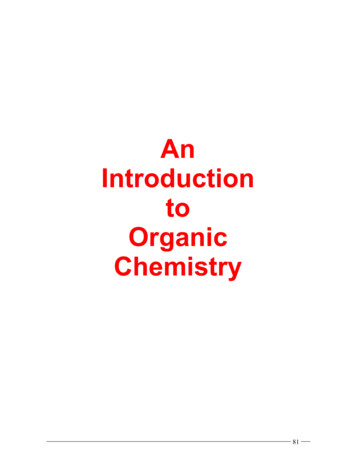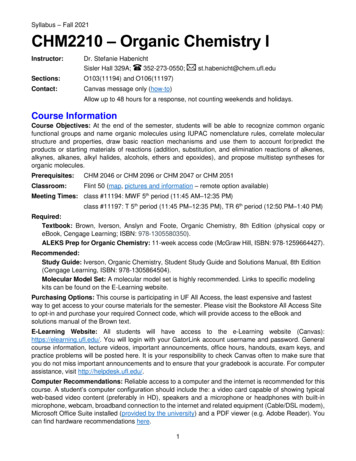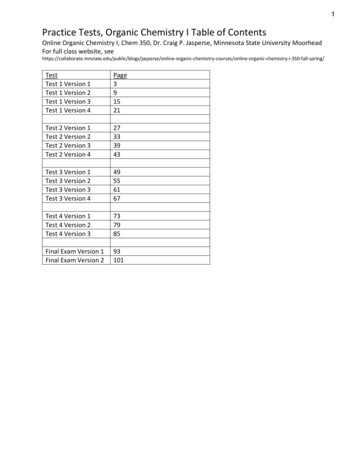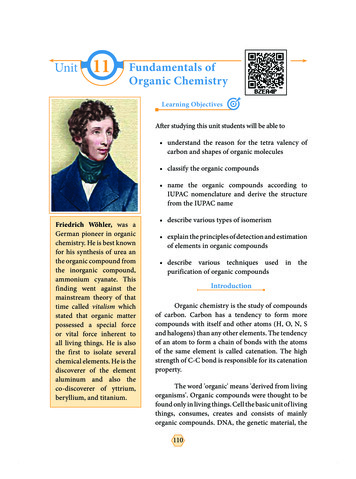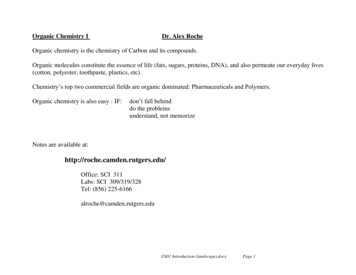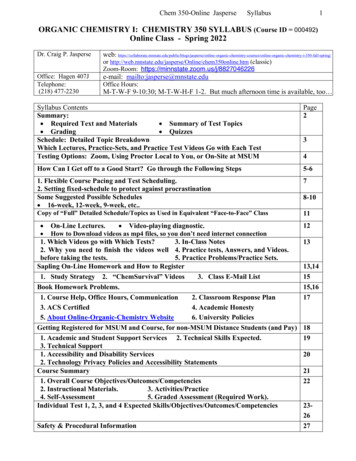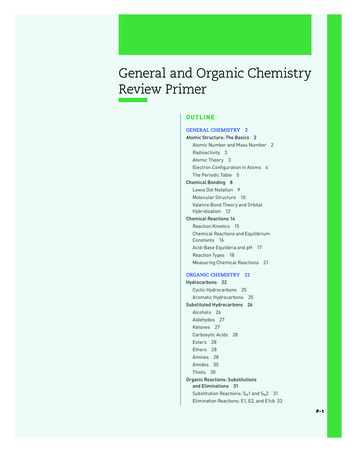
Transcription
General and Organic ChemistryReview PrimerOUTLINEGENERAL CHEMISTRY2Atomic Structure: The Basics 2Atomic Number and Mass Number 2Radioactivity 3Atomic Theory 3Electron Configuration in Atoms 4The Periodic Table 5Chemical Bonding 8Lewis Dot Notation 9Molecular Structure 10Valence Bond Theory and OrbitalHybridization 12Chemical Reactions 14Reaction Kinetics 15Chemical Reactions and EquilibriumConstants 16Acid-Base Equilibria and pH 17Reaction Types 18Measuring Chemical Reactions 21ORGANIC CHEMISTRY 21Hydrocarbons 22Cyclic Hydrocarbons 25Aromatic Hydrocarbons 25Substituted Hydrocarbons 26Alcohols 26Aldehydes 27Ketones 27Carboxylic Acids 28Esters 28Ethers 28Amines 28Amides 30Thiols 30Organic Reactions: Substitutionsand Eliminations 31Substitution Reactions: SN1 and SN2 31Elimination Reactions: E1, E2, and E1cb 33P -1McKee Primer.indd 127/05/15 8:17 pm
P-2General and Organic Chemistry Review PrimerBIOCHEMISTRY COURSES ARE ALWAYS FAST-PACED AND CHALLENGING.It is for this reason that success is highly dependent on a student’s background in general andorganic chemistry. Although courses in these subjects are prerequisites, students often havetrouble recalling the detailed chemical information that will help them understand the chemi-cal processes in living organisms. This review is divided into two sections: general and organicchemistry. General chemistry topics include atomic structure, chemical bonding, acids and bases,and the chemical properties of the principal elements found in living organisms. Topics in the organic chemistry section include the structure and chemical properties of carbon-containing compounds, nucleophiles and electrophiles, functional group structure and chemical behavior, andorganic reaction classes. Topics that are directly relevant to biochemistry (e.g., biomolecule classes,pH, buffers, kinetics, and thermodynamics) are described within the textbook.GENERAL CHEMISTRYChemistry is the investigation of matter and the changes it can undergo. Matter,which can be described as physical substances that occupy space and have mass,is composed of various combinations of the chemical elements. Each chemicalelement is a pure substance that is composed of one type of atom. About 98 of the118 known elements occur on earth and an even smaller number occur naturallyin living organisms. These elements fall into three categories: metals (substancessuch as sodium and magnesium with high electrical and heat conductivity, metallic luster, and malleability), nonmetals (elements such as nitrogen, oxygen, andsulfur, which are defined as a group because of their lack of metallic properties),and metalloids (elements such as silicon and boron, which have properties intermediate between metals and nonmetals).The review of general chemistry includes an overview of atomic structure,atomic electron configurations, the periodic table, chemical bonds, valence bondtheory, chemical reaction types, reaction kinetics, and equilibrium constants.Atomic Structure: The BasicsAtoms are the smallest units of an element that retain the property of that element. Atomic structure consists of a positively charged central nucleus surrounded by one or more negatively charged electrons. With the exception of theelement hydrogen (H), the dense, positively charged nucleus contains positivelycharged protons and neutrons, which have no charge. (The hydrogen nucleusconsists of a single proton.) Atoms are electrically neutral so the number of protons is equal to the number of electrons. When atoms gain or lose one or moreelectrons, they become charged particles called ions. Ions formed when atomslose electrons, called cations, are positively charged because they have fewerelectrons than protons. For example, when a sodium atom (Na) loses an electron,it becomes the positively charged ion Na1. Ions formed by the gain of electrons,called anions, are negatively charged. Chlorine (Cl) gains an electron to form thechlorine ion Cl2.ATOMIC NUMBER AND MASS NUMBER Elements are identified by theiratomic number and mass number. The atomic number of an element is thenumber of protons in its nucleus. The atomic number uniquely identifies anMcKee Primer.indd 227/05/15 8:17 pm
General and Organic Chemistry Review PrimerP-3element. Carbon (C) has 6 protons in its nucleus, so its atomic number is 6. Anyatom with 16 protons in its nucleus is an atom of sulfur (S).The mass number of an element, measured in atomic mass units, is equal tothe number of protons and neutrons. Calculating an element’s mass number iscomplicated by the existence of isotopes, atoms of an element with the samenumber of protons but different numbers of neutrons.Many naturally occurring elements exist as a mixture of isotopes. For example,carbon has three naturally occurring isotopes containing six, seven, and eightneutrons, called carbon-12, carbon-13, and carbon-14, respectively. Carbon-12,the most abundant carbon isotope, is used as a reference standard in the measurement of atomic mass. An atomic mass unit (µ) or dalton (Da), named after thechemist John Dalton, is defined as one twelfth of the mass of an atom of carbon-12.Because the isotopes of an element do not occur with equal frequency, the averageatomic mass unit (the weighted average of the atomic masses of the naturallyoccurring isotopes) is used. For example, hydrogen has three isotopes: hydrogen-1, hydrogen-2 (deuterium), and hydrogen-3 (tritium), which contain zero,one, and two neutrons, respectively. The average atomic mass for hydrogen is1.0078 µ. This number is very close to 1.0 because hydrogen-1 has an abundanceof more than 99.98%.RADIOACTIVITY Some isotopes are radioactive (i.e., they undergo radioactivedecay, a spontaneous process in which an atomic nucleus undergoes a changethat is accompanied by an energy emission). For example, relatively unstablecarbon-14 undergoes a form of radioactive decay, referred to as b-decay. Inb-decay one neutron in the atom’s nucleus is converted into a proton and anelectron. The new proton converts the carbon-14 atom to a stable nitrogen-14atom. The newly created electron is emitted as a b-particle. Hydrogen-3 (tritium)also decays to form the more stable helium-3 (a rare isotope of helium with oneneutron instead of two) by the emission of a b-particle. Essentially, the unstabletritium nucleus, which contains one proton and two neutrons, decays to form thehelium-3 isotope (two protons and one neutron).ATOMIC THEORY According to the Bohr model of atoms, electrons are incircular orbits with fixed energy levels that occur at specific distances from thenucleus. When an atom absorbs energy, an electron moves from its “groundstate” to a higher energy level. The electron returns to its ground state when theatom releases the absorbed energy. As quantum theory revolutionized physics inthe early twentieth century, it became apparent that the theory explained manyproperties of atoms that the Bohr model did not.Quantum theory is based on the principle that both matter and energy havethe properties of particles and waves. Using quantum theory, physicists andchemists eventually described an atomic model in which electrons are predictedto occur in complex orbitals that are essentially probability clouds. An orbital isa probability distribution (i.e., variations in an orbital’s cloud density correlatewith the probability of finding an electron). The different shapes and sizes oforbital clouds depend on the energy level of the electrons within them. Together,four quantum numbers describe the configuration of the electrons and the orbitals in an atom.The principal quantum number n defines the average distance of an orbitalfrom the nucleus where n 1, 2, 3, etc. In other words, the quantum number ndesignates the principal energy shell. The higher its n value, the farther an electron is from the nucleus.The angular momentum quantum number l (lower case L) determines theshape of an orbital. The l values of 0, 1, 2, 3, and 4 correspond to the s, p, d, andf subshells. Note that the value of n indicates the total number of subshells withinthe principal energy shell. So if n 3, the atom’s principal shell has threeMcKee Primer.indd 327/05/15 8:17 pm
P-4General and Organic Chemistry Review Primersubshells with l values of 0, 1, and 2. In such an atom the principal energy shellwould contain s, p, and d orbitals. Each subshell also has a specific shape. The sorbital is spherical with the nucleus at its center. Each p orbital is dumbbell-shapedand each d orbital is double dumbbell-shaped. The shape of f orbitals is extremelycomplex and is not discussed further.The magnetic quantum number m describes an orbital’s orientation in space.Values of m range from –l to l. With an s orbital, l 0 so the value of m is 0.For p orbitals, the value of l is 1, so m is equal to –1, 0, or –1 (i.e., there are threeorbitals designated px, py, and pz (Figure 1). For d orbitals l 2, so there are fivepossible orientations: –2, –1, 0, 1, or 2.zzzFIGUR E 1The 2p OrbitalsThree 2p orbitals areoriented at right angles toeach other.yxx2pxSubshell-FillingSequenceAll of the subshells of agiven value of n are onthe same horizontal line.The filling sequence isdetermined by followingthe arrows starting at thelower left.7p6s5s4s3s2s1sMcKee Primer.indd 4x2py2pzThe fourth quantum number is the spin quantum number ms, which describesthe direction in which an electron is rotating: clockwise or counterclockwise. Thevalues for ms can be either 1/2 or –1/2. Because the Pauli exclusion principlestates that each electron in an atom has a unique set of the four quantum numbers,it follows that when two electrons are in the same orbital, they must have oppositespins. Such spins are described as “paired.” The spinning of an electron createsa magnetic field. Diamagnetic atoms such as nitrogen are not attracted to magnets because they have paired electrons (i.e., the magnetic fields of the pairedelectrons cancel out). Atoms that contain unpaired electrons (e.g., oxygen) arereferred to as paramagnetic because they are attracted to magnets.FIGUR E 27syy6p6d5p5d4p4d3p2p3d5f4fELECTRON CONFIGURATION IN ATOMS Knowing how electrons aredistributed in atoms is essential to any understanding of how chemical bonds areformed. There are several rules concerning electron distribution. The most basicrule is the Aufbau principle, which stipulates that electrons are put into orbitals,two at a time, in the order of increasing orbital energy (i.e., the inner orbitals arefilled before the outer, higher-energy orbitals). Chemists use a shorthand methodto illustrate how electrons are arranged around the nucleus of a ground-stateatom (an atom at its lowest possible energy state). The electron configurationpattern useful for the elements relevant to living organisms is as follows:1s22s22p63s23p64s23d104p65s24d105p66s2.The superscripts in the electron configuration pattern indicate the maximumnumber of electrons in each subshell. Note that because of orbital overlaps, theorder of the orbitals being filled becomes more complicated as the filling patternprogresses. Figure 2 is a diagram that will aid in recalling the order in which thesubshells are filled.Determining an element’s electron configuration requires knowing its atomicnumber (the number of protons), which is also equal to the number of electrons.Using the electron configuration pattern, the element’s electrons are then used tofill in the orbitals beginning with the lowest energy level. For example, the electron configurations of hydrogen (1 electron) and helium (2 electrons) are 1s1 and1s2, respectively. Similarly, the electron configurations for carbon (6 electrons)and chlorine (17 electrons) are 1s22s22p2 and 1s22s22p63s23p5, respectively. According to Hund’s rule, when an energy subshell has more than one orbital(e.g., p and d orbitals) there is only 1 electron allowed in each orbital until all the27/05/15 8:17 pm
General and Organic Chemistry Review PrimerP-5orbitals have 1 electron. Such electrons have parallel spins. As additional electrons enter the orbitals, they will spin pair with the previously unpaired electrons.The orbital diagrams of nitrogen and oxygen illustrate this or many elements, an electron configuration also reveals how many valenceelectrons there are. Valence electrons, the electrons in the s and p orbitals of theoutermost energy level, determine the element’s chemistry (i.e., how it will reactwith other elements). For example, oxygen atoms with an electron configurationof 1s22s22p4 have six valence electrons (i.e., there are a total of six electrons in its2s and 2p orbitals). Chlorine has seven valence electrons because there are sevenelectrons in its 3s and 3p orbitals. For many elements, atoms will react so thattheir outermost energy level or valence shell is filled, which is the most stableconfiguration they can have. The term octet rule is used to describe this phenomenon because the atoms of most elements react so that their valence shells containeight electrons. Hydrogen and lithium are two obvious exceptions. Because a hydrogen atom only has one electron in its 1s orbital, it can gain one electron whenit reacts to form a 1s2 orbital or it can give up an electron to form a proton (H1).With three electrons, lithium (Li) has a 1s22s1 configuration. By losing its onevalence electron, lithium atoms gain stability by having a filled 1s shell (two electrons). In the reaction of lithium with chlorine forming lithium chloride (LiCl),lithium gives up one electron to become a lithium ion (Li1). The lithium valenceelectron is donated to chlorine to form the chloride ion (Cl2). Chlorine has therebyincreased its valence shell from seven to eight electrons. Understanding the significance of electron configurations, valence, and other properties of the elementsis enhanced by familiarity with the periodic table of the elements, which is discussed next. It should be noted that the term oxidation state is often used in reference to atoms that have gained or lost electrons. The lithium ion, for example,has a 11 oxidation state and the chloride ion has a 21 oxidation state.THE PERIODIC TABLE The modern periodic table (Figure 3) is a chart basedon the periodic law, which states that the electron configurations of the elementsvary periodically with their atomic number. The properties of the elements thatdepend on their electronic configuration, therefore, also change with increasingatomic number in a periodic pattern. The periodic table is arranged in verticalrows called groups or families and horizontal rows called periods. Certaincharacteristics of the elements increase or decrease along the vertical or horizontalrows. These characteristics, which affect chemical reactivity, are atomic radius,ionization energy, electron affinity, and electronegativity. The atomic radius of aneutral atom is the distance from the nucleus to the outermost electron orbital.Ionization energy is defined as the amount of energy required to remove thehighest energy electron from each atom in 1 mol of the atoms in the gaseous state(i.e., how strongly an atom holds on to its electrons). Electron affinity is theenergy that is released when an electron is added to an atom. Electronegativity isthe tendency of an atom to attract electrons to itself.Each of the seven horizontal rows of the periodic table, called periods, beginswith an element with a new shell with its first electron. For example, there is oneelectron in the 2s, 3s, and 4s subshells of lithium, sodium, and potassium (K),respectively. The atomic radii of the elements in groups 1, 2, and 13 to 18 decrease from left to right. As the number of positively charged protons at the centerof the atom increases, the negatively charged electrons are attracted more strongly(i.e., the electrons are drawn closer to the nucleus). The same trend is not seen inMcKee Primer.indd 527/05/15 8:17 pm
P-6General and Organic Chemistry Review PrimerTHE PERIODIC TABLE OF THE ELEMENTSIUPACgroupsTraditionalgroups 3Li4Be36.941 9.0121112NaMg422.99 24.301920KCa539.10 40.083738RbSr685.47 87.625556CsBa7132.9 137.38788FrRa[223.0] [226.0]KeyAtomic numberSymbol27CoAtomic mass CuZnGa54.94 55.85 58.93 58.69 63.55 65.39 69.7243444546474849TcRuRhPdAgCdIn[98.91] 101.1 102.9 106.4 107.9 112.4 114.875767778798081ReOsIrPtAuHgTl186.2 190.1 192.2 195.1 197.0 200.6 204.4107108109UnsUnoUne[262.1] [265.1] 4656667686970LaCePrNdPmSmEuGdTbDyHoErTmYb138.9 140.1 140.9 144.2 [144.9] 150.4 152.0 157.2 158.9 162.5 164.9 167.3 168.9 mBkCfEsFmMdNo227.0 232.0 231.0 238.0 [237.0] [244.1] [243.1] [247.1] [247.1] [251.1] [252.1] [257.1] [258.1] [259.1]Values in brackets are masses of most stable isotopes.FIGUR E 3The Periodic TableIn the modern periodictable elements are organized on the basis of theiratomic numbers, electronconfigurations and recurring chemical properties.Note that the Lanthanides(elements 57–70) andthe Actinides (elements89–102) are not relevantto biochemistry and arenot discussed.McKee Primer.indd 6the atomic radii of the elements in groups 3 to 12. There is little reduction inatomic size in these elements because of the repulsion between the 4s and 3delectrons.The ionization energies of the elements in a period typically increase withincreasing atomic number. As the atomic radii decrease across a period (i.e., thedistance between the outer electron and the nucleus of the atoms decreases), moreenergy is required to remove the outer electron. For example, it is easier to removean electron from lithium (atomic number 3) than from nitrogen (N) (atomicnumber 7).Electron affinity, which can be thought of as the likelihood that a neutral atomwill gain an electron, increases from left to right across periods. Metals such assodium (1s22s22p63s1) have low electron affinities because they become morestable when they lose valence electrons. Elements on the right side of the periodictable have high electron affinities because of vacancies in their valence shells.Chlorine (1s22s22p63s23p5) has a very high electron affinity because it releases alarge amount of energy to become more stable as the chloride ion when it fills itsvalence shell by gaining one electron. The noble gases [e.g., helium (He), neon(Ne), and argon (Ar)] in group 18 do not conform to this trend because their valence shells are filled; hence, they are chemically unreactive.Electronegativity, a measure of an atom’s affinity for electrons in a chemicalbond, increases across a period as atomic radii are decreasing. In the water molecule (H2O), for example, oxygen is more electronegative than the hydrogenatoms because oxygen’s larger nucleus strongly attracts its electrons. Hence, inwater molecules the electrons in the bonds between each of the two hydrogenatoms and the oxygen atom are shared unequally.The 18 vertical rows of the periodic table consist of elements with similarchemical and physical properties. The group 1 elements all have one electron in27/05/15 8:17 pm
General and Organic Chemistry Review PrimerP-7their outermost shell. With the exception of hydrogen, all of the group 1 elements[lithium (Li), sodium (Na), potassium (K), rubidium (Rb), cesium (Cs), and therare radioactive francium (Fr)] are referred to as the alkali metals because theyreact vigorously with water to form hydroxides (e.g., NaOH). The alkali metalsdo so because they readily lose their single valence electron to form cations witha 1 charge. For example, sodium (1s22s22p63s1) reacts with water to form sodiumhydroxide (NaOH) and hydrogen gas (H2). NaOH then dissociates to form Na1and OH2. Because the alkali metals donate their valence electron so readily, theyare considered especially strong reducing agents. (Reducing agents are elementsor compounds that donate electrons in chemical reactions.) Of all the alkalimetals, only sodium and potassium have normal functions in living organisms.For example, the balance of sodium ions and potassium ions across the plasmamembrane of neurons is critical to the transmission of nerve impulses.The group 2 alkaline earth metals [beryllium (Be), magnesium (Mg), calcium(Ca), strontium (Sr), barium (Ba), and radium (Ra)] have two electrons in theiroutermost shell. The electron configurations for the biologically important group 2elements magnesium (DNA structure and enzyme function) and calcium (bonestructure and muscle contraction) are 1s22s22p63s2 and 1s22s22p63s2 3p64s2, respectively. With the exception of beryllium, the alkaline earth metals lose theirtwo valence electrons to form cations with a 12 charge [e.g., they react withwater to form metal hydroxides such as Ca(OH)2]. Like the group 1 metals, thealkaline earth metals are strong reducing agents, although each element is somewhat less reactive than the alkali metal that precedes it.Groups 3 to 12 are referred to as the d-block elements because electrons progressively fill the d orbitals. The majority of the d-block elements are the transition elements, which have incompletely filled d orbitals. Zinc (Zn, atomicnumber 30) is not considered a transition metal because its 3d subshell has 10electrons. Because electron configurations of elements with high atomic numbers are unwieldy, chemists use a simplification for an element’s electron configuration that is an abbreviation for the electron configuration of the noble gasimmediately preceding the element. For example, zinc’s electron configurationcan be described as [Ar]3d104s2.The transition elements are metals with special properties. Among these are thecapacities to have more than one oxidation state and to form colored compounds.Iron is a transition metal found in a large number of proteins in all living organisms. It most notably occurs in hemoglobin, the oxygen-transport protein thatgives blood its red color. Iron atoms ([Ar]3d64s2) can form a wide range of oxidation states from –2 to 6, but its most common oxidation states are 2 and 3.Neutral iron atoms can form the 2 ion because the 4s orbital and the 3d orbitalshave very similar energies, so that the removal of two electrons to form Fe12([Ar]3d6) requires little energy. The loss of an additional electron to form Fe13{[Ar]3d5} requires more energy.In addition to iron, several other d-block elements are important in living organisms. Manganese (Mn) is found in numerous enzymes in all living organisms. Cobalt (Co) is an important component of vitamin B12 structure. Nickel(Ni) occurs in several enzymes in microorganisms and plants. Copper (Cu) isfound in several energy generation proteins. Zinc (Zn) occurs in over 100 enzymes and has structural roles in numerous proteins. Molybdenum (Mo) has avital role in nitrogen fixation.The remaining elements in the standard periodic table, groups 13 to 18, are inthe p block, so named because electrons progressively fill p orbitals. The p-blockelements found in living organisms (carbon, nitrogen, phosphorus, sulfur, chlorine, and iodine) are nonmetals. Carbon (1s22s22p2) in group 14 has four electronsavailable to form stable bonds both with other carbon atoms and with a variety ofother elements (most notably hydrogen, oxygen, nitrogen, and sulfur). As a result,carbon can form an almost infinite number of compounds. Carbon is the crucialMcKee Primer.indd 727/05/15 8:17 pm
P-8General and Organic Chemistry Review PrimerWORKED PROBLEM 1Consider the element potassium (atomic number 19). What is its electronicconfiguration? How many electrons are in its valence shell? Is elemental potassium paramagnetic or diamagnetic?SOLUTIONThe number of electrons in the potassium atom is equal to its atomic number, 19.Using the Aufbau and Pauli exclusion principles and Hund’s rule, the electronicconfiguration is 1s22s22p63s23p64s1. Potassium has one valence electron becauseits outermost energy level (4s) has one electron. Elemental potassium is paramagnetic because it has one unpaired electron in its valence shell.element in most biomolecules, with the exceptions of molecules such as water andammonia and the electrolytes (e.g., Na1, K1, and Mg12). (An electrolyte is an ionicspecies that influences the distribution of electric charge and the flow of wateracross membranes.) Because nitrogen (1s22s22p3) has five electrons in its outershell, its valence is 23. In biomolecules nitrogen is found in amines (R-NH2,where R is a carbon-containing group) and amides (e.g., bonds between aminoacids in proteins). Phosphorus (1s22s22p63s23p3), in the nitrogen family, mostcommonly occurs in living organisms as phosphate (PO4–3); (e.g., in the nucleicacids DNA and RNA and as a structural component of bones and teeth). In livingorganisms, oxygen (1s22s22p4) is found most abundantly in water molecules,where it has an oxidation state of 22. Oxygen atoms are also found in all themajor classes of biomolecules (e.g., proteins, carbohydrates, fats, and nucleicacids). Sulfur ([Ne]3s23p6), the second member of the oxygen family, is found inproteins and small molecules such as the vitamin thiamine. It often occurs inbiomolecules in the form of thiols (R-SH) and disulfides (R-S-S-R). Of all themembers of the halogen family (group 17), only chlorine ([Ne]3s23p5) and iodine([Kr]5s2 4d105p5) routinely occur in living organisms. The functions of chlorine inthe form of the chloride ion include the digestion of protein in the animal stomach[hydrochloric acid (HCl)] and its function as an electrolyte. Iodine is a componentof the thyroid hormones, which regulate diverse metabolic processes in the animalbody. It should be noted that phosphorus, sulfur, and chlorine are usually assignedvalences of –3, –2, and –1, respectively. However, because they have vacant d orbitals, they can expand their valence shell and form different oxidation states. Forexample, phosphorus has a 5 valence in phosphoric acid (H3PO4), sulfur has avalence of 6 in the sulfate ion (SO42–), and chlorine has a 1 valence in thehypochlorite ion (ClO –).Chemical BondingA chemical bond is a strong attractive force between the atoms in a chemicalcompound. Chemical bonds form because of interactions between atoms thatinvolve the rearrangement of their outer shell electrons. According to the octetrule, atoms react so as to achieve the outer electron configuration of the noblegases. They do so because complete outer valence shells are stable because of areduction in stored potential energy.Two major types of chemical bonds are ionic and covalent. The bonds differin how valence electrons are shared among the bonded atoms. Ionic bonds formwhen electrons are transferred from atoms with a tendency to release electrons(e.g., alkali or alkaline earth metals) to electronegative atoms that tend to gainelectrons. The transfer process results in the formation of oppositely chargedatoms called ions. The positively charged ion product is called a cation, and thenegatively charged ion product is called an anion. For example, the transfer ofMcKee Primer.indd 827/05/15 8:17 pm
General and Organic Chemistry Review Primersodium’s single electron to chlorine (valence 7) yields the cation Na1 and theanion Cl2. The ionic bond in NaCl is the electrostatic attraction between thepositive and negative ions.In covalent bonds electrons are shared between atoms with similar electronegativity values. A single covalent bond consists of two shared electrons. Forexample, there is one covalent bond in molecular hydrogen (H2). The two hydrogen atoms, with one electron each, complete their valence shell by sharing theirelectrons. Elements such as carbon, nitrogen, and oxygen can form multiple covalent bonds. Carbon, for example, can form double and triple bonds. In themolecule ethylene a carbon-carbon double bond involves the sharing of two setsof valence electrons. The triple covalent bond in molecular nitrogen (N2) is anexample of the sharing of three sets of valence electrons.Covalent bonds between atoms with moderate differences in electronegativityare referred to as polar covalent bonds. In such bonds the electrons are sharedunequally, with the electron density shifted toward the atom with the greaterelectronegativity. The electrical asymmetry in such bonds causes one end of themolecule to possess a slightly negative charge and the other end a slightly positive charge. These partial charges are indicated by the lowercase Greek letterd: d1 and d . For example, in the water molecule H2O the oxygen atom has asignificantly larger electronegativity value than the hydrogen atoms. As a result,the electron pairs between oxygen and each of the hydrogen atoms are drawncloser to the oxygen atom. Each hydrogen atom has a partial positive charge (d1)and the oxygen has a partial negative charge (d ).In a coordinate covalent bond, a shared pair of electrons in the bond comesfrom one atom. The reaction between ammonia (NH3) and HCl provides a simpleexample. The product ammonium chloride (NH4Cl) results when a covalent bondis formed between the nitrogen with its lone pair and the proton that has dissociated from HCl. HHNP-9HCl –HLEWIS DOT NOTATION Chemists often describe chemical bonds using Lewisdot structures. Devised by the chemist G. N. Lewis, Lewis dot structures are ashorthand notation for explaining how the valence electrons of the atoms invarious compounds combine to form covalent bonds. Molecular hydrogen (H2
GENERAL CHEMISTRY Chemistry is the investigation of matter and the changes it can undergo. Matter, which can be described as physical substances that occupy space and have mass, is composed of various combinations of the chemical elements. Each chemical element is a pure substa

